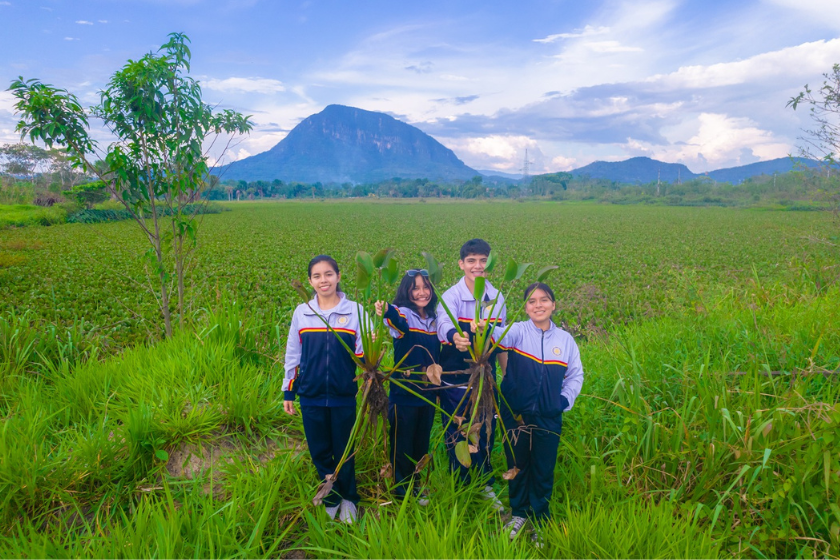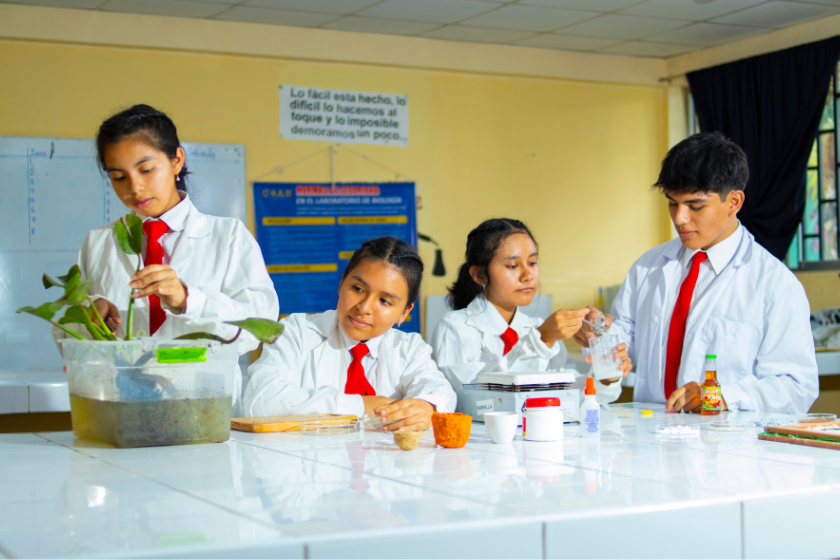Known locally as lechuguin, the water hyacinth is common in Peru and is considered a pest because it proliferates very quickly and causes a great headache for the local population. Wherever it grows, water hyacinth reduces the biodiversity of aquatic flora and fauna, destroys the habitat of various species, and, therefore, has consequences for fishing. But, based on this problem, young people from the San Martín region saw an opportunity to manufacture sustainable products: cups made of bioplastic (plastic derived from renewable biomass sources) and natural fertilizer. The innovation was a finalist in the 10th edition of Solve for Tomorrow in the country.
The team consists of four students from the High-Performance College (COAR) of San Martín, in the city of Moyobamba, Amazon region of Peru. At the time of the project development, they were between 15 and 17 years old and were in the 3rd, 4th, and 5th year of secondary school (the last three years of compulsory schooling). In Peru, COARs offer a free boarding educational model, where students live at school during the school term. They have a curriculum that combines courses, academic advice, self-study spaces, and recreational, sports, artistic, and technological workshops.
At the Development class, project-based-learning with social impact is encouraged. Students are divided in groups, according to friendships and affinities, to choose and investigate a topic. “Lechuguines en acción” (“Water hyacinth in action”, in spanish), as the initiative was called, had fertilizers as its starting point. “A countless number of ideas arose to be able to develop this one, but they were not successful. After offering them a series of project alternatives, they said that they knew of a bioremediable plant,” recalls the mediator teacher, Kenide Sandoval, a Chemistry teacher. This means that, due to its biological properties, hyacinth can capture waste (organic, metal, mud, and other components) in the water and thus, remedy and purify the place where it is located.

Although it has that positive side already discovered with bibliographic research, the problem lies in the rapid growth of water hyacinth, to the point of losing control and dominating the environment, leaving little space and nutrients for other species. This situation is very visible in the community, in places such as the Isla del Amor lagoon, with approximately nine hectares. It is located in the Calzada district, 20 minutes from Moyobamba (by car).
With the support of the mayor, they began to collect the plants to take them to the school laboratory, where they did all the tests. “They began to investigate and came to the conclusion that this plant could also be used to make fertilizers”, says the educator. But with more searching, they realized that a better use would be to first use the hyacinth to produce bioplastics and only after that process compost the waste. This technological solution begins with a very manual procedure: chopping and drying the carvings and leaves.
In Science, the projects do not end. We have to think that we are going to have many difficulties that will provide us with alternatives for improvement,” believes the teacher.
The educator believes that for the project to be successful it is necessary to encourage students to look for answers on their own: “I didn’t tell them whether an idea was going to work or not, but only that they should try.” For Sandoval, learning in Science also means an exercise in patience and resilience. “My role is to always motivate them so that they do not lose interest due to the difficulties of the project,” he declares.
Cellulose becomes cup and fertilizer
After they are dry, the plants are crushed and strained, and then alkaline hydrolysis is applied to extract the cellulose, then is mixed with ingredients at 80ºC and finally, the paste is placed in a mold and let it dry. Done! You now have a new glass made of water hyacinth! “We are using these containers for experiments in the laboratory,” adds the teacher. It is possible to adapt the prototype into various formats and uses.

With the waste from the process, sustainable fertilizer is now produced. However, there was a new and unexpected challenge: the compost had a very strong smell. “The group began to investigate and citric acid was used, which managed to whiten the product, making it more pleasant, and softening the smell,” explains the teacher. He also highlights that the project can be improved, expanded, and continued if they have allies and budgets. “Perhaps this experience can be consider as a precedent for other creations as well,” he says.
The teacher points out that participating in Solve for Tomorrow was not only an opportunity to challenge learning by going beyond ideas but also by generating solutions that help people. “The students developed technical knowledge while realizing that they can make a difference”.




